A Naturalist's Weekend: Exploring Fungi, Fire and Beetles
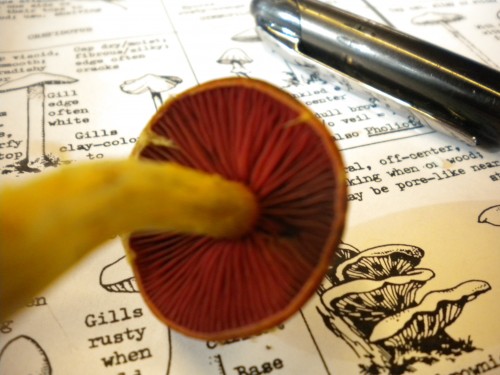
After several weeks of preparing for and teaching fall Mountain School, graduate students of Cohort 10 momentarily stepped away from their roles as instructors and transitioned back to being eager students. The occasion was our fall graduate retreat, where we spent several days with various North Cascades Institute staff and friends studying and observing natural history in the North Cascades ecosystem. Our retreat offered a diverse range of topics that took us to nearby forests in the Upper Skagit Valley to east side pine forests in the Methow Valley.
Fungi were the first order of business on our three-day retreat. We met with Lee Whitford, a former NCI staff member and C2 graduate, who led us in a mushroom collection and identification lesson. Together we explored nearby National Forest land, scouting and harvesting mushroom specimens. At first glance, the mushrooms were difficult to find as we searched the thick, mossy underbrush of the forest. But our observant eyes did not fail us and fungi appeared everywhere!
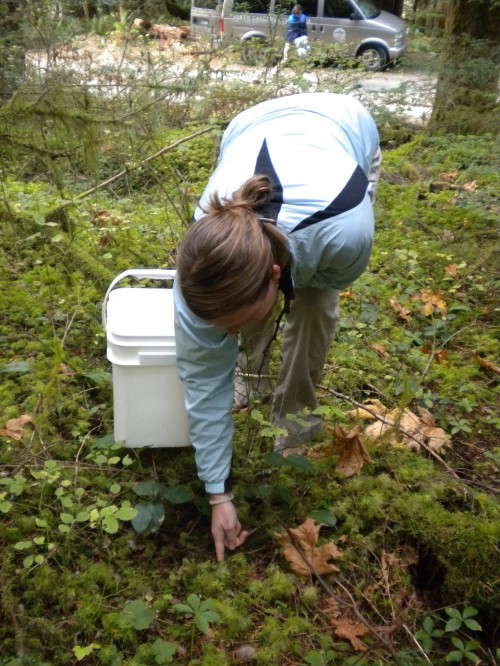 Graduate student Kate Rinder searches for mushrooms
Graduate student Kate Rinder searches for mushrooms
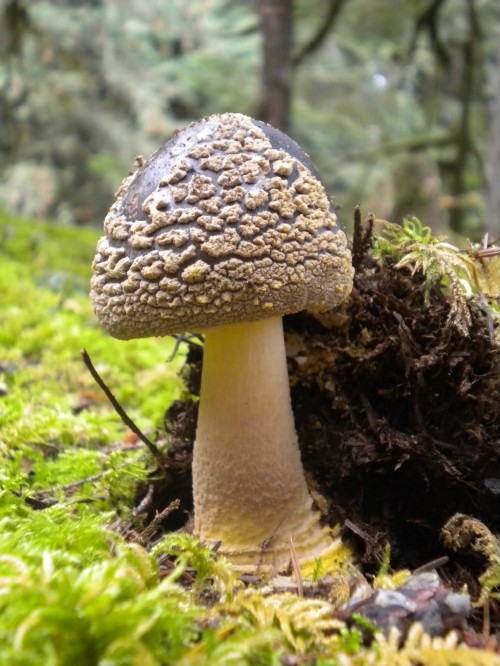 A newly sprouted mushroom emerges through the mossy forest floor
A newly sprouted mushroom emerges through the mossy forest floor
Buckets full later we created an impressive display along the dining hall table at the Environmental Learning Center. Mushrooms, large and small, came in an assortment of colors: light and dark brown, pink, yellow, purple, white and gray. We practiced mushroom identification techniques and with the assistance of Angela Mele, an artist-illustrator participating in North Cascade National Park’s Artist in Residence program, sketched some of the most prized mushrooms collected that day. Our harvesting really paid off when we discovered chanterelles, lobster mushrooms and matsutakes among our collection, which we cooked and ate later that evening.
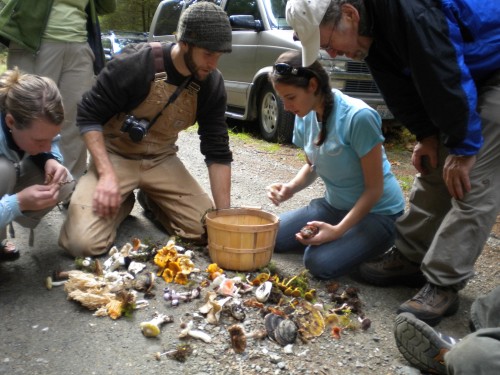 Grads and staff examine the assortment of mushrooms they collected
Grads and staff examine the assortment of mushrooms they collected
 CeCe Bowerman and Nick Mickula identify and sketch mushrooms collected earlier that day
CeCe Bowerman and Nick Mickula identify and sketch mushrooms collected earlier that day
Day two led us to the Methow Valley to explore fire ecology in the Tripod Fire region. This fire erupted in 2006 and burned more than 175,000 acres. We met with Katie Roloson, an NCI staff member and C7 graduate who studied fire ecology during her tenure with the graduate program, and Dana Visalli, a botonist and editor of the Methow Naturalist. We meandered our way up a gravel Forest Service road, stopping along the way to point out various topographic aspects that influenced the direction and intensity of this historic fire.
The air was cold, still and silent, except for the occasional bird call in a nearby tree. The majority of tree stands stood charred along the mountainsides. In most areas signs of revegetation have occurred as the forest works to restore itself. Other areas remain barren.
In the afternoon we completed our studies with a hike along the Freezeout Ridge Trail near Tiffany Mountain. We sauntered through the charred trees, which looked like an endless array of black matchsticks. It may have taken us an hour to walk a mile and reach our destination to an open meadow as each person made unique observations along the hike and was anxious to share with the group. Mushrooms, plants, fire scars and butterflies were among the shared discoveries. We soon learned what happens when you take more than a dozen naturalists on a hike.
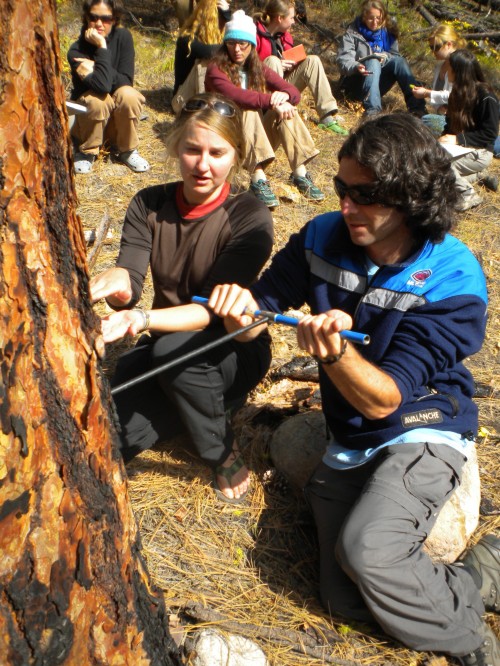 Katie Roloson guides grad student David Strich through a tree core sample in a ponderosa pine that survived the 2006 Tripod Fire
Katie Roloson guides grad student David Strich through a tree core sample in a ponderosa pine that survived the 2006 Tripod Fire
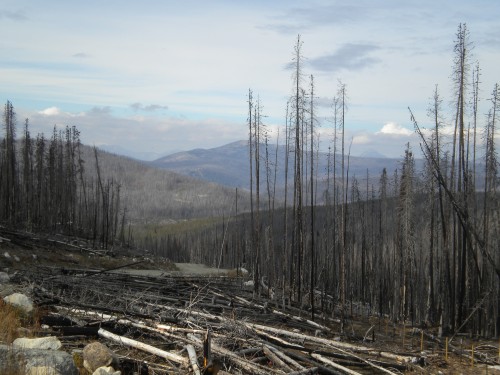 Remains of the Tripod Fire near Freezeout Pass
Remains of the Tripod Fire near Freezeout Pass
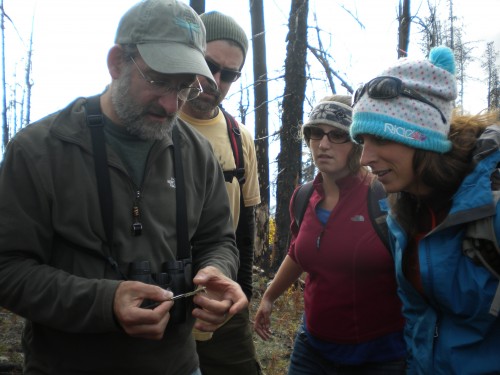 Saul Weisberg, NCI executive director, shows grad students how to carefully handle a butterfly
Saul Weisberg, NCI executive director, shows grad students how to carefully handle a butterfly
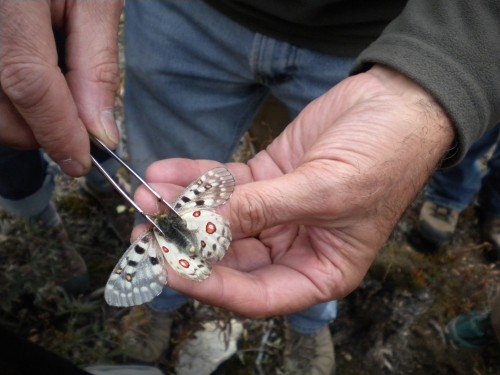 A mountain parnassian found near the edge of the Freezeout Ridge Trail is put on display
A mountain parnassian found near the edge of the Freezeout Ridge Trail is put on display
We took time in a meadow at the top of the trail to scatter and explore this place for ourselves, to listen, think and be still. Photographs were taken, sketches were made and words written. The view from the vantage point showed large rolling hills of charred forests with pockets of sagebrush and pine. The sky carried a blue-gray haze across the landscape. A highlight of this experience came near the end of this time when a wolf howl was bellowed by retreat participants to bring the group back together. What ensued was yips and howls from coyotes in the nearby valley below. We stood in awe listening to the harmonious calls that echoed throughout the mountainsides. It was a welcomed surprise that reminded us we were not alone in the quiet valley of the Methow.
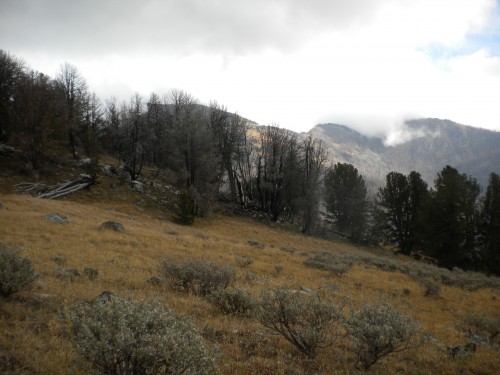 View from the meadow on the Freezeout Ridge Trail
View from the meadow on the Freezeout Ridge Trail
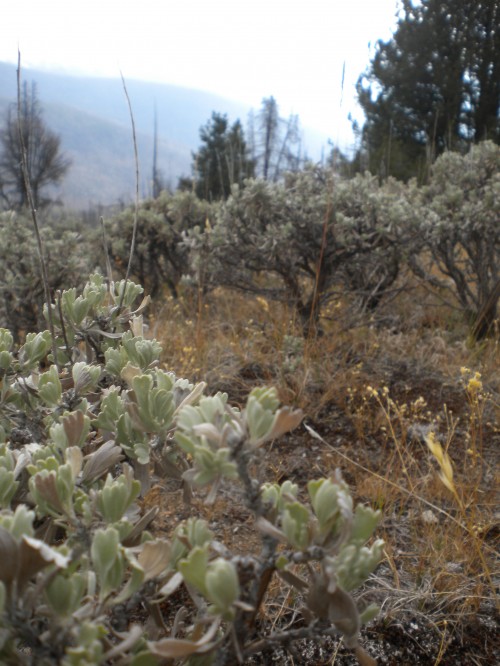 Patches of sagebrush mixed with the pine forest atop the meadow on the Freezeout Ridge Trail
Patches of sagebrush mixed with the pine forest atop the meadow on the Freezeout Ridge Trail
On the third and final day of our retreat we slowly headed back to the ELC. On our way we met C9 graduate student Megan Magee, who showed us signs of the mountain pine beetle at the Lone Fir Loop Trail near Washington Pass. During our walk we observed signs of the beetle in stands of lodgepole pine. Signs of beetle invasions were plentiful in this area. The mountain pine beetle, a native species, has bored its way into these trees, creating dead stands with brittle, brown crowns and yellow, popcorn-shaped pitch along the tree trunks—signifying a lost battle to survive a mountain pine beetle invasion.
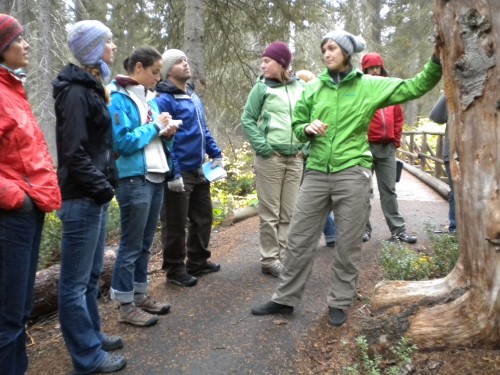 Megan Magee, C9 graduate student, discusses signs of the mountain pine beetle with C10 grads
Megan Magee, C9 graduate student, discusses signs of the mountain pine beetle with C10 grads
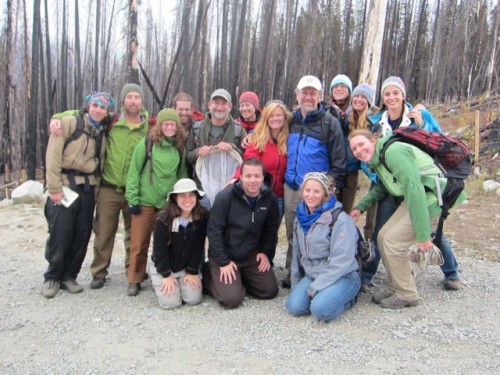 Fall grad retreat participants together at the trailhead of the Freezeout Ridge Trail
Fall grad retreat participants together at the trailhead of the Freezeout Ridge Trail
As we concluded our retreat we felt renewed, having explored the natural world and celebrating nature’s wonders with others who are just as curious to learn more. The following week we stepped back into our instructor and educator roles with more knowledge to share with Mountain School students and a keen eye for fungi, fire scars and mountain pine beetle.
Photos courtesy of Codi Hamblin and Lee Whitford.
